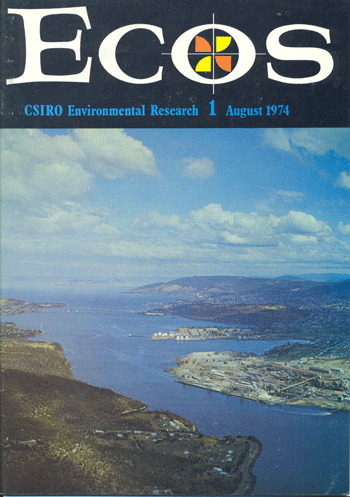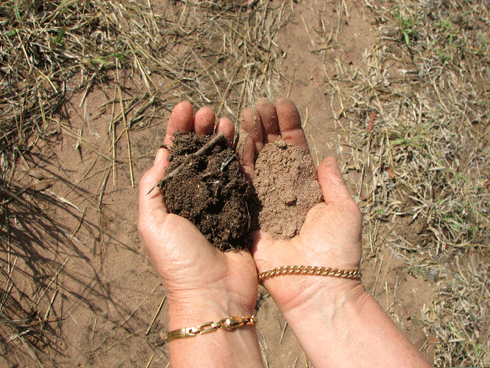
|
Published: 4 July 2011
The next chapter of Ecos reporting
This is the final print edition of Ecos as the magazine evolves to more regular online publication. We retrace some of the highlights of the magazine’s long service as a national environment title, and cast forward to its online future.

|
|
The very first edition of Ecos in August 1974 included a story on monitoring carbon dioxide to investigate the possibility of a global greenhouse effect. Credit: CSIRO
|
Ecos has been one of the country’s longest running environmental magazines. It was launched by CSIRO in 1974, during the Whitlam era – a time of rapid cultural shift, when Australians began to embrace social change. Conscription was abolished, the women’s movement gained momentum, and banks issued the first bankcards, triggering a new era of ‘buy now, pay later’ consumption.
This was also a time when environmentalism entered the mainstream, and Australians began questioning the environmental impacts of unconstrained industrial, technological and economic ‘progress’ – including extensive land clearing and pollution.
In his foreword to the first issue of Ecos, then-Chairman of CSIRO, JR Price, wrote of the need for the organisation to provide the public with ‘ready access to scientific knowledge’ on environmental matters. The aim of Ecos then was to educate and inform Australians about environmental issues through coverage of relevant CSIRO research.
As one of the few such magazines publicly available, Ecos was widely read across the education, research and government sectors, as well as by the science-educated public at libraries in suburbs and towns across the country. The magazine never had a commercial objective; it was distributed from Melbourne free of charge.
Ecos often introduced Australians to emerging environmental issues – many of which continue to be ‘live’ today. For example, the August 1974 first edition included a story on monitoring carbon dioxide to investigate the possibility of a global greenhouse effect. The evolution of climate research and debate in our region has now been recorded through the unique Ecos online archive of more than 5000 articles in 161 issues. The same is true of research on myriad other key topics, such as Australia’s drought and bushfire history, renewable energy technology and sustainable agriculture.
Early editions of Ecos presciently raised awareness about the possibility of a future food crisis, and the connection between drought and El Niño. Energy savings in the home, the urban heat island effect, the prospect of peak oil, and the roles of the deep ocean, forests and uncleared land as carbon sinks were also discussed.1
Ecos no. 4 (May 1975) featured an article on ‘unconventional sources of water’, with CSIRO scientists suggesting storing treated stormwater in natural aquifers around Adelaide. The concept is now a reality, following many years of CSIRO research on water treatment and aquifer behaviour.2
In 1998, CSIRO Publishing launched Ecos’ first companion website, providing the community with open access to archived articles in PDF format and past issues back to 1984. Since then, Ecos’ online readership has grown significantly.
Also in the 1990s, the concepts of sustainable development and ecological sustainability matured in mainstream discussion about society’s impacts and direction. In line with diversification of its own research agenda, CSIRO recognised the opportunity to re-launch Ecos as a broader sustainability magazine. The publication still aimed to cover environmental research, but not in every article, and not exclusively CSIRO’s work. The challenge was to engage more ‘non-scientists’ with readable articles covering the spectrum of environmental economic and social issues, while maintaining relevance to key decision makers.
Today, with environmental issues dominating public discourse, the need for publications such as Ecos is as critical as ever. As the debate on climate change has evolved over the past decade, Ecos has often been a step ahead of the mainstream media: clarifying the complex science around issues, addressing misconceptions and providing a depth of critical enquiry not possible in rapid daily media reporting. The magazine has had the advantage of direct access to CSIRO’s leading research.
Ecos took the initiative early on to explain the critical importance of soil carbon to Australia – in both improving soil viability in carbon-depleted agricultural land, and locking up carbon dioxide from the atmosphere.3

|
|
Ecos Issue 140 highlighted impending ecosystem impacts from planned development activities in the pristine Chain of Bays region on the Eyre Peninsula. Credit: Courtesy of Grant Hobson
|
We have also alerted readers to urgent conservation threats. For example, in 2008 Ecos highlighted the impending ecosystem impacts of planned development activities in the pristine Chain of Bays section of South Australia’s Eyre Peninsula.4 The story helped escalate the priority of the issue: the area is now protected by legislation, and support funding has been awarded for local research, educational and indigenous cultural programs.
The idyllic cover of Ecos 142 (April–May 2008) pointed readers to another climate change impact that is likely to have major ramifications for the planet – acid oceans. Our story revealed how increasing levels of atmospheric carbon dioxide are acidifying seawater in the upper ocean, threatening life forms such as coral and certain phytoplankton – tiny plant cells that are the foundation of the marine food chain.
Ecos has been privileged to publish the perspectives of many high-profile writers and researchers, including leading scientists, who have been fundamental to the publication’s recognised quality and enduring following. In 2000, the magazine received a Banksia Environmental Foundation media award endorsement – an acknowledgement of the efforts of a very small but dedicated editorial team.
In 2011, Ecos has continued to invigorate discussion on science and sustainability. Our stories in Ecos 160 on the Government’s National Carbon Farming Initiative, a green waste biofuel industry for Australia, native animals as pets, and baseload solar thermal power generation have been picked up by many other media outlets.5 In this way, Ecos has been able to connect radio presenters, journalists and online media with the relevant scientists, enabling them to explain their research to the wider community.
July 2011 marks a new chapter for Ecos, as an internet-only publication. CSIRO’s decision to cease the printed format was based on both economics and serving evolving readership preferences. Online readership of Ecos articles has continued to grow steadily, while income from printed distribution has declined significantly against unsupportable costs. Print format also has a large environmental footprint.

|
|
The cover image of Ecos 142 (April–May 2008) represented the issue’s lead story on the acidification of the world’s oceans from carbon dioxide uptake. Credit: iStockphoto
|
Open-access online publication of Ecos means CSIRO can continue to fund the same quality content, and also allows us to deliver articles more regularly.
Rolling publication on the website will be linked to today’s most popular social media channels, delivering Ecos to readers around the world. These channels also facilitate interaction between readers, scientists and writers, supporting CSIRO’s continuing objective for the magazine: to foster understanding and discussion of the role of research in addressing sustainability issues.
As Australia struggles to understand and negotiate complex, interlinked environmental, economic and societal challenges, Ecos will – with the help of its expert network – continue to seek out and publish positive, solutions-based information. We welcome your continuing support in that mission.
In closing, we would like to acknowledge the efforts, talent, and commitment of the staff, Ecos Advisory Committee members and associates, and others who have contributed to the significant impact of the printed edition of Ecos over 161 issues.
1 You can read more about Ecos’ history in Issue 150 – see http://tiny.cc/g7z5d
2 See www.csiro.au/resources/ASTRbottledwater.html
3 See Issue 141, page 30, http://tiny.cc/xwf2u
4 Issue 140, http://tiny.cc/kt5xu
5 See http://tiny.cc/7kwjs




